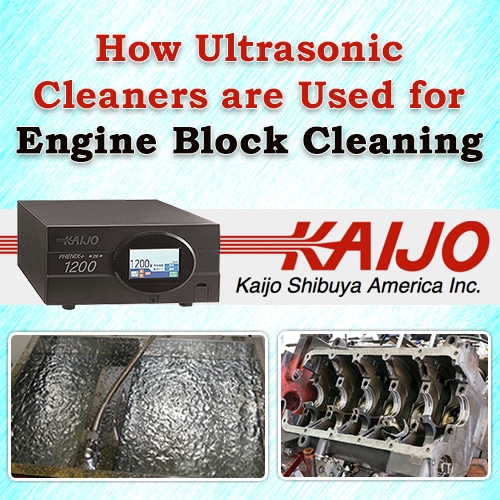How Ultrasonic Cleaners Are Used for Engine Block Cleaning
April 20, 2021
 Because cleaning engine blocks with traditional methods is time-consuming and difficult, the use of ultrasonic cleaners is attractive. Ultrasonic technology removes heavy surface dirt completely, and quickly cleans down to the original surface. Ultrasonic cleaners don’t rely on harsh chemicals or lengthy soaking. Instead, they clean safely and without monitoring. Powerful automotive ultrasonic cleaners can clean even heavily contaminated engine blocks as well as other engine parts used in re-building. They can provide an effective, environmentally friendly alternative to traditional cleaning methods.
Because cleaning engine blocks with traditional methods is time-consuming and difficult, the use of ultrasonic cleaners is attractive. Ultrasonic technology removes heavy surface dirt completely, and quickly cleans down to the original surface. Ultrasonic cleaners don’t rely on harsh chemicals or lengthy soaking. Instead, they clean safely and without monitoring. Powerful automotive ultrasonic cleaners can clean even heavily contaminated engine blocks as well as other engine parts used in re-building. They can provide an effective, environmentally friendly alternative to traditional cleaning methods.
Automotive Ultrasonic Cleaners Can Easily Remove Engine Block Deposits
Ultrasonic cleaners work by generating microscopic bubbles in the cleaning solution. The bubbles form and collapse in tune with the ultrasonic frequency. When they collapse, they create a tiny but energetic jet that strikes the engine block surface and dislodges deposits.
Low frequencies create comparatively large bubbles and correspondingly powerful jets. The lowest frequency ultrasonic cleaners operate at around 26 kHz and their cleaning action is suitable for robust parts with hard surfaces such as engine blocks. Automotive parts with softer surfaces or delicate surface coatings are better cleaned at higher frequencies to avoid pitting. Engine blocks have hard enough surfaces that even the lowest frequencies won’t cause any damage.
To clean large automotive parts such as engine blocks, the parts have to be completely submerged in the cleaning solution. A suitable tank will hold the engine block with a clearance of several inches to facilitate the circulation of the cleaning solution and its bubbles. The bubbles form everywhere the cleaning solution can penetrate, even inside cavities and threaded holes. The complex shape and many surfaces that make an engine block hard to clean are easily cleaned by the bubbles of an ultrasonic cleaner.
Automotive Ultrasonic Cleaners Provide Substantial Benefits
When automotive ultrasonic cleaners remove heavy deposits from engine blocks and other automotive parts, their operation delivers significant benefits to an automotive shop. If they transition to ultrasonic technology, shops can see better cleaning performance, reduced costs, increased efficiency and a safer working environment.
Cleaning with an ultrasonic cleaner is faster than traditional methods. Rather than cleaning with extended soaking and lengthy manual scrubbing, employees can place the engine block into an adequately sized ultrasonic cleaning tank, set a timer and come back later to remove the clean engine block. A follow-up manual cleaning for hard-to-clean spots is not necessary.
Operating costs are low because ultrasonic cleaners can work with plain water as the cleaning solution. For greasy or oily deposits, adding a mild detergent or solvent can speed up cleaning. Hardened deposits are often removed more quickly if the cleaning solution is heated. Overall operating costs are lower due to reduced use of expensive chemicals and less employee time spent on cleaning.
Faster cleaning and fewer man-hours translate into a higher operating efficiency. The workplace is safer as well, due to the absence of toxic chemicals and less manual cleaning that can result in injury during scraping and wire brushing. Operations are more predictable and shops can plan re-building and restoration activity based on the reliable availability of clean parts.
Kaijo Can Help Automotive Shops Transition to Ultrasonic Technology
With its extensive experience in ultrasonic technology and it’s in house expertise, Kaijo can advise automotive shops on the types of ultrasonic systems needed for their cleaning applications. While engine blocks are best cleaned at comparatively low frequencies, other parts may require higher frequencies and a multi-frequency system may be appropriate. Power levels, tank size and number of ultrasonic transducers can all play a role in ultrasonic system performance. Kaijo offers free consultation, and after analyzing the application, can suggest ultrasonic system configurations and make sure they perform as needed.





